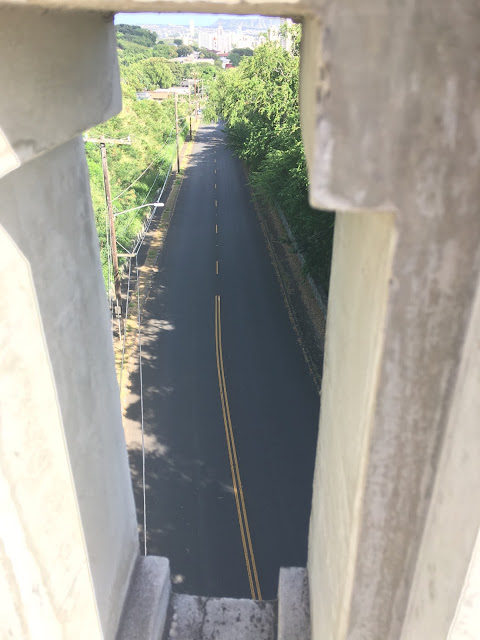Puowaina Bridge is majestic. Elegant. Regal. Even the pukas bear fine craftsmanship, more than the usual bridges on Oahu.
It fits. The road that takes drivers to Punchbowl Cemetery — National Memorial Cemetery of the Pacific — is the same one that leads to the bridge, which crosses above Auwaiolimu Street and into Papakolea Hawaiian Homesteads. Historic, yes.
Here is how the Historic Hawaii Foundation summarizes Punchbowl:
> Puowaina is a volcanic crater approximately oval in shape. ... The use of careful landscaping and flat grave markers has been enhanced by the impressive memorial erected by the American Battle Monuments Commission. As a sit of pre-historic significance, Puowaina has a deep religious meaning for the Hawaiian people long before Western contact with the islands in 1778.
Puowaina means "Hill of Sacrifice" and this is where offenders of a certain "kapu" were taken to be sacrificed.
Wikipedia:
> The first known use was as an altar where Hawaiians offered human sacrifices to their gods and killed violators of the many taboos. Later, during the reign of Kamehameha the Great, a battery of two cannons was mounted at the rim of the crater to salute distinguished arrivals and signify important occasions.
52perfectdays.com lists Puowaina on its 52 Haunted Sites of Hawaii.
> There are still restless ghosts who roam the area.
Structural Systems Inc. did work under the bridge in 2017 to counter an erosion issue, or slope stabilization. Prior to the project, the Puowaina Drive bridge was listed as one of the 10 most in need of help.
Google Puowaina Bridge and the Puowaina Young Riders pops up. They began in 1999, not long after the powerful Punchbowl Aliis folded. I remember playing for Boys Club Tigers (before they became Boys and Girls Club) in 1979, and Punchbowl was mighty on the gridiron.
One note: since its construction in 1936, the bridge has been practical and, perhaps, life-saving. East-bound drivers heading into Papakolea don’t have to make a left turn into traffic. Or drive further down the road to take the left turn there. A simple right turn into Puowaina Drive leads to the bridge 50 feet over traffic.
And, finally, from historian Peter Young:
> A 1916 article in Scientific Monthly described it: “The Hawaiian name for this venerable crater is Pu-o-Waina and it has a tragic significance. The original form, from which the modern spelling is abbreviated, was Puu O waiho ana, literally the hill of offering or sacrifice.”


It fits. The road that takes drivers to Punchbowl Cemetery — National Memorial Cemetery of the Pacific — is the same one that leads to the bridge, which crosses above Auwaiolimu Street and into Papakolea Hawaiian Homesteads. Historic, yes.
Here is how the Historic Hawaii Foundation summarizes Punchbowl:
> Puowaina is a volcanic crater approximately oval in shape. ... The use of careful landscaping and flat grave markers has been enhanced by the impressive memorial erected by the American Battle Monuments Commission. As a sit of pre-historic significance, Puowaina has a deep religious meaning for the Hawaiian people long before Western contact with the islands in 1778.
Puowaina means "Hill of Sacrifice" and this is where offenders of a certain "kapu" were taken to be sacrificed.
Wikipedia:
> The first known use was as an altar where Hawaiians offered human sacrifices to their gods and killed violators of the many taboos. Later, during the reign of Kamehameha the Great, a battery of two cannons was mounted at the rim of the crater to salute distinguished arrivals and signify important occasions.
52perfectdays.com lists Puowaina on its 52 Haunted Sites of Hawaii.
> There are still restless ghosts who roam the area.
Structural Systems Inc. did work under the bridge in 2017 to counter an erosion issue, or slope stabilization. Prior to the project, the Puowaina Drive bridge was listed as one of the 10 most in need of help.
Google Puowaina Bridge and the Puowaina Young Riders pops up. They began in 1999, not long after the powerful Punchbowl Aliis folded. I remember playing for Boys Club Tigers (before they became Boys and Girls Club) in 1979, and Punchbowl was mighty on the gridiron.
One note: since its construction in 1936, the bridge has been practical and, perhaps, life-saving. East-bound drivers heading into Papakolea don’t have to make a left turn into traffic. Or drive further down the road to take the left turn there. A simple right turn into Puowaina Drive leads to the bridge 50 feet over traffic.
And, finally, from historian Peter Young:
> A 1916 article in Scientific Monthly described it: “The Hawaiian name for this venerable crater is Pu-o-Waina and it has a tragic significance. The original form, from which the modern spelling is abbreviated, was Puu O waiho ana, literally the hill of offering or sacrifice.”
















Comments